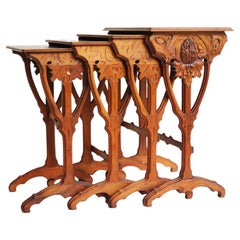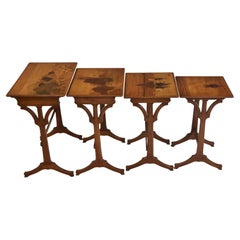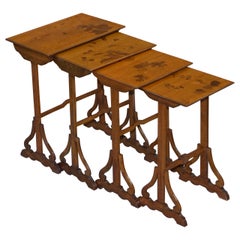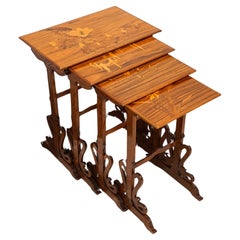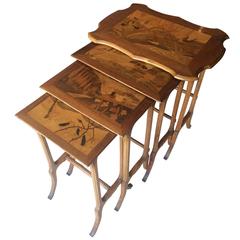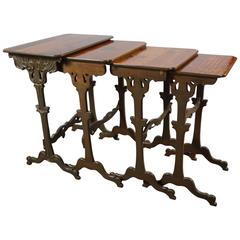Emile Galle Nesting Tables
Antique Early 1900s French Art Nouveau Nesting Tables and Stacking Tables
Wood, Walnut
Early 20th Century French Art Nouveau Nesting Tables and Stacking Tables
Beech
Antique 19th Century French Art Nouveau Nesting Tables and Stacking Tables
Oak
Antique 19th Century French Art Nouveau Nesting Tables and Stacking Tables
Satinwood
Antique Early 1900s French Art Nouveau Side Tables
Walnut
Recent Sales
Antique Early 1900s French Art Nouveau Nesting Tables and Stacking Tables
Wood
Antique Early 1900s French Art Nouveau Nesting Tables and Stacking Tables
Fruitwood, Walnut
Antique Early 1900s French Art Nouveau Nesting Tables and Stacking Tables
Walnut
20th Century French Nesting Tables and Stacking Tables
Wood
Early 20th Century French Art Nouveau Nesting Tables and Stacking Tables
Antique Early 1900s French Art Nouveau Nesting Tables and Stacking Tables
Antique Early 1900s French Art Nouveau Nesting Tables and Stacking Tables
Antique Early 1900s French Art Nouveau Nesting Tables and Stacking Tables
Beech
Antique Early 1900s French Art Nouveau Nesting Tables and Stacking Tables
Wood
Antique Early 1900s French Art Nouveau Nesting Tables and Stacking Tables
Beech
Antique Early 1900s French Art Nouveau Nesting Tables and Stacking Tables
Mahogany
Early 20th Century French Art Nouveau Nesting Tables and Stacking Tables
Mahogany
Early 20th Century French Art Nouveau Nesting Tables and Stacking Tables
Early 20th Century French Art Nouveau Nesting Tables and Stacking Tables
Wood
Early 20th Century French Art Nouveau Tables
Wood, Beech
20th Century French Art Nouveau Nesting Tables and Stacking Tables
Wood
Antique Early 1900s French Art Nouveau Nesting Tables and Stacking Tables
Beech
Vintage 1920s French Art Deco Nesting Tables and Stacking Tables
Wood
Antique 19th Century French Art Nouveau Nesting Tables and Stacking Tables
Fruitwood
20th Century French Nesting Tables and Stacking Tables
Early 20th Century French Nesting Tables and Stacking Tables
Walnut
Antique 1890s British Edwardian Nesting Tables and Stacking Tables
Kingwood
People Also Browsed
Antique 19th Century English Chinese Chippendale Vitrines
Glass, Mahogany
Antique Early 1900s French Art Nouveau Vases
Glass
Early 20th Century American Art Nouveau Table Lamps
Bronze, Wire
Vintage 1920s French Art Deco Table Lamps
Art Glass
Vintage 1920s French Art Nouveau Glass
Art Glass
Early 20th Century American Edwardian Table Lamps
Bronze
Antique Early 19th Century French Art Nouveau Armchairs
Wood
Antique Late 19th Century French Art Nouveau Tray Tables
Beech, Nutwood, Satinwood, Walnut
Antique Early 1900s American Art Nouveau Table Lamps
Bronze
Vintage 1910s American Art Nouveau Table Lamps
Bronze
Antique Early 1900s French Art Nouveau Glass
Glass
Antique Early 1900s French Art Nouveau Glass
Glass
Antique Early 1900s American Arts and Crafts Candlesticks
Bronze
Antique 19th Century French Tray Tables
Fruitwood
Vintage 1910s French Art Nouveau Chandeliers and Pendants
Wrought Iron
Antique Early 1900s English Art Nouveau Cabinets
Mother-of-Pearl, Mahogany
Émile Gallé for sale on 1stDibs
“Art for art’s sake” was a belief strongly espoused by the celebrated French designer and glassworker Émile Gallé. Through his ethereal glass vases, other vessels and lamps, which he adorned with botanical and religious motifs, Gallé advanced the Art Nouveau ideology and led the modern renaissance of French glass.
Gallé was the son of successful faience and furniture maker Charles Gallé but studied philosophy and botany before coming to glassmaking later in life. The young Gallé’s expertise in botany, however, would inform his design style and become his signature for generations to come.
After learning the art of glassmaking, Gallé went to work at his father’s factory in Nancy. He initially created clear glass objects but later began to experiment with layering deeply colored glass.
While glassmakers on Murano had applied layers of glass and color on decorative objects before Gallé had, he was ever-venturesome in his northeastern France, taking advantage of defects that materialized during his processes and etching in natural forms like insects such as dragonflies, marine life, the sun, vines, fruits and flowers modeled from local specimens.
Gallé is also credited with reviving cameo glass, a glassware style that originated in Rome. He used cabochons, which were applied raised-glass decorations colored with metallic oxides and made to resemble rich jeweling. Gallé's cameo glass vases and vessels were widely popular at the Paris Exhibition of 1878, cementing his position as a talented designer and pioneer.
During the late 19th century, Gallé led breakthroughs in mass production and employed hundreds of artisans in his workshop.
Botany and nature remained great sources of inspiration for the artist's glassmaking — just as they had for other Art Nouveau designers. From approximately 1890 to 1910, the movement’s talented designers produced furniture, glass and architecture in the form of — or adorned with — gently intertwining trees, flowers and vines. But Gallé had many interests, such as Eastern art and ceramics. The Japanese collection he visited at the Victoria and Albert Museum in London (then the South Kensington Museum) during the 1870s had made an impression too.
Breaking free from the rigid Victorian traditions, Gallé infused new life and spirit into the art and design of his time through exquisitely crafted glass vessels and pioneering new glassworking techniques.
Find a collection of Émile Gallé vases and other furniture and decorative objects on 1stDibs.
Finding the Right Nesting-tables-stacking-tables for You
Antique and vintage nesting tables and stacking tables first became popular in the early 1800s. With individual tables being used for afternoon tea, needlework and other activities, nesting tables were a perfect solution to clear up clutter at the end of the day.
These tables remained a staple of interiors over the decades for their versatility. In the 1920s, German-born American artist Josef Albers designed a modern version with each table a different color. At the Bauhaus, the German art and design school and chief crucible of modernism founded by architect Walter Gropius, Albers wasn’t the only designer to reinterpret the nesting table. Hungarian-born architect Marcel Breuer also introduced a model with chrome-plated tubular steel legs and lacquered plywood surfaces.
One can now find a range of gorgeous, carefully crafted designs, such as a three-level set of solid oak nesting tables, naturally oiled and finished with Calacatta marble. A game-themed set of nesting tables is a must-have for a living room or lounge, while a small office can be accented with vintage Scandinavian nesting tables made of teakwood, a sought-after material among mid-century modern designers.
Browse the unique collection of antique and vintage stacking tables and nesting tables on 1stDibs to find hundreds of options to match your office or living space.
